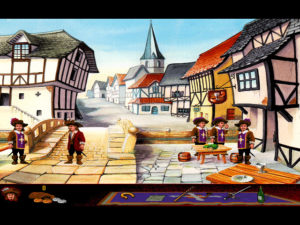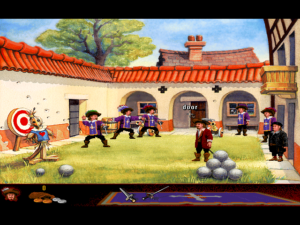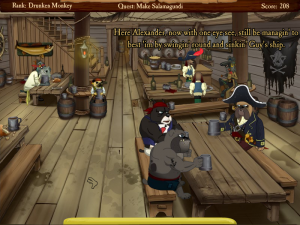Touché!: Accidental Cruelty?
It’s been nearly two weeks since my last post. Time seems to be passing at a faster than normal rate these days. But also, when we last left Geoffroi le Brun, I was resorting to stuff like “try everything in your inventory on every environmental feature that you can use inventory items on”, and still not really getting anywhere, and that didn’t really make me feel like continuing. Today, I went so far as to browse the strings in TOUCHE.DAT — something I don’t like to do, because it’s nigh impossible to avoid spoilers. I didn’t need to look very deeply, though, before I had an inkling about what my problem was. An inkling that I didn’t like, but which seems to bear out so far.
As you may recall, I was trying to recover William de Peuple’s will from a highwayman. Consulting with the Musketeer captain back at base, I found reason to suspect that the highwayman had gone to Le Mans. The problem, then, is that my travel pass didn’t cover Le Mans, and the captain refused to extend it until I got certified in marksmanship. “Just talk to Atoff”, he said. Atoff is the Musketeer in charge of training. Just one problem: he wasn’t around. Everyone except the captain and D’Artagnan had left to throw rotten fruit at a suspected witch pilloried in the town square, although they weren’t to be seen there either.
I had been assuming that I could get him back somehow, probably by freeing the witch. What my cursory examination of the data showed was a lack of any obvious text about this among the interactions with the witch. And that got me thinking.
See, the thing is, the appearance of the pillory is linked to your visits to Juliette. The game makes you find three different ways up to her tower by changing what’s in the area after each visit. The pillory is the final step in this process, giving you access to rotten fruit that leads, in a roundabout way involving several other puzzles and a trip to Paris, to Juliette’s father leaving the house so you don’t have to sneak in through the window any more. I had put the game into this state some time back, and as a result, Atoff was no longer where I needed him. But what if I just didn’t make the witch appear in the first place? Juliette is pretty much optional until somewhat later in the story. Going back to an earlier save, I can just leave her alone until after I’ve had a chance to talk to Atoff about the marksmanship test.
The thing that bothers me is that this is so very much a game in the mold of Monkey Island, but it seems to be violating one of its core design principles here: that no matter what the player does, the game should never cut off the possibility of victory. Certainly the rest of the game has followed this principle, so it really looks like this one moment of Cruelty is a mistake. And yet, it’s a mistake that would have been inevitably found by adequate playtesting! A player who doesn’t already know what they’re supposed to be doing will very likely drive Atoff away before encountering the highwayman, even if they only visit Juliette when given a concrete reason.
I could still be wrong about this. Maybe there really is a way to get Atoff back after he leaves. But if so, I can say with confidence that this constitutes an optional puzzle, one that some players will skip without knowing they skipped anything. In effect, reverse cruelty. And that still doesn’t seem like it’s in this game’s style, or Monkey Island‘s.
Geoffroi cheats on the test, by the way. This is one of the few moments where he really seems like he’s doing what Guybrush would do.
 Comments(0)
Comments(0)

